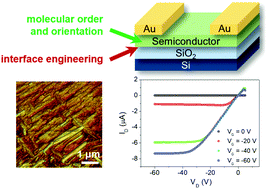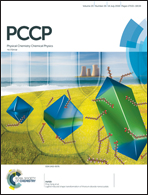Interface engineering and solid-state organization for triindole-based p-type organic thin-film transistors†
Abstract
Inspired by the excellent device performance of triindole-based semiconductors in electronic and optoelectronic devices, the relationship between the solid-state organization and the charge-transporting properties of an easily accessible series of triindole derivatives is reported herein. The vacuum-evaporated organic thin-film transistors (OTFTs) exhibited a non ideal behaviour with a double slope in the saturation curves. Moreover, the treatment of the gate insulator of the OTFT device with either a self-assembled monolayer (SAM) or a polymer controls the molecular growth and the film morphology of the semiconducting layer, as shown by X-ray diffraction (XRD) analyses, atomic force microscopy (AFM) and theoretical calculations. N-Trihexyltriindole exhibited the best device performance with hole mobilities up to 0.1 cm2 V−1 s−1 at the low VG range and up to 0.01 cm2 V−1 s−1 at high VG, as well as enhanced Ion/Ioff ratios of around 106. The results suggest that the non-ideal behaviour of the here studied OTFT devices could be related to the higher interfacial disorder in comparison to that in the bulk.



 Please wait while we load your content...
Please wait while we load your content...